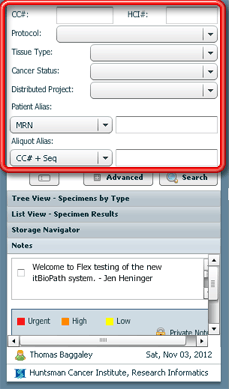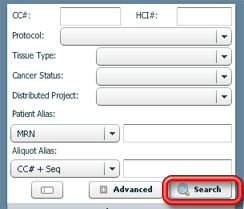- Welcome
- Use case
- Getting Started
-
Searching Records
- Performing a Basic Search
- Performing an Advanced Search
- Performing a List Search
- Performing a Keyword Search of UUMC Pathology Reports for all Patients in the Database
- Performing a Keyword Search of UUMC Pathology Reports for the Patients Associated with a Specific Set of Specimens
- Restrictions on Searches
- Reports
-
iQ Tool
- Adding Columns to a Query
- Starting the iQ Tool
- iQ Tool Window
- Current Query Data Group
- Saved Queries List
- Top Portion of the Selected
- Display or Report Columns Section
- Find/Filters Section
- Running a Preexisting Query
- Creating a Query
- Create Query Window
- Copying and Altering a Preexisting Query
- Removing Columns from a Query
- Editing Column Parameters in a Query
- Changing the Order of Columns in a Query
- Adding Filters to a Query
- Editing Filters in a Query
- Ways of Comparing Data
- Removing Filters From a Query
- Results Window
- Application Data Structure
- Application Database Fields Alphabetical List
- Application Datatree
- Field Paths List for the iQ Tool
-
Adding Specimens to the Database
- Adding a Single Specimen using the Add Specimen Wizard
- Adding a Batch of Specimens using the Add Specimen Expert Tool
- Saving a Batch of Specimens to be added as a Work in Progress
- Finishing a Work in Progress Batch
- Printing Barcodes for a Specimens in a Batch added using the Add Specimen Expert Tool
- Customizing the Add Specimen Expert Tool to Streamline Specimen Batch Entry
- Changing which Box an Add Expert Template Points for Adding Storage
- Importing FFPE Samples from UUMC
- Entering and Editing Specimen Records
- Transformations
- Specimen Disbursement and Registration
- Reports and Records
- Adding a Pathology Report to a Specimen Record
- Performing a DEXT Import of a Pathology Import
- Checking on the status of your DEXT Import Request
- Adding a Medical Record to a Specimen Record
- Editing Patient or Collection Records
- Editing Collection Records
- Editing Patient Records
- Diagnoses
- Adding a Diagnosis to a Patient Record
- Linking an Existing Diagnosis to one or more Collections
- Linking a Collection to a Diagnosis
- Recording a Consent for a Patient
- Reviewing a Patient's Consents
- Uploading a Patient's Consent Form
- Managing Patient Consents
- External (to itBioPath) Data Sources
- Managing Dictionaries
-
Storage
- Editing Aliquots
- Connecting a Barcode Label Printer to itBioPath
- Removing a Barcode Label Printer from itBioPath
- Freezer Management
- Viewing the Contents of a Box in a Freezer
- Accessing the Specimen Record for the Specimen associated with an Aliquot
- Editing Box Details
- Adding a New Box to a Freezer from the Add Aliquot Window
- Managing Protocols, Projects, and Related User Permissions
- Window, Tab, and Field Descriptions
- Miscellaneous
A basic search allows the user to search for specimens based on several of the most commonly used traits, such as the specimen's cancer center number (unique ID), its HCI number (an ID used as an identifier for the collection), the protocol under which the specimen was collected, the specimen's tissue type or cancer status, or a project the specimen has been distributed to.
To perform a basic search:
1. Enter or select a value in the appropriate text box or dropdown field on the Search Pane of the application.

In the Cancer Center # field, by just entering the first part of the number and the search will return all of the samples that begin with the digits indicated. This can be very useful if you want to find only samples added to the database during a particular year, since the first two digits of a Cancer Center Number are the last two digits of the year that the sample was collected. Other than this, wildcards symbols that stand for and define the parameters of certain unspecified characters in a search are not supported — you must enter or select the exact matching value in the field.
The Cancer Center # can be entered by scanning a barcode. Activate the Cancer Center # field (click on it) and scan the barcode on a specimen storage unit with a hand scanner attached to your computer. This is a quick way to open the sample detail window for a sample if you have one of the storage units for that specimen in your possession. Although the scanned number will not appear exactly in the same format as a standard Cancer Center #, itBioPath is able to recognize the barcode format and find the correct sample.
2. Click on the Search button to initiate the search based on the criteria you have entered.

The search results tabs (Tree View, List View) will populate all of the specimens in the database that meet the criteria specified. As a default, the Tree View will be selected to display your results. Click the List View to see a simple list of the search results. — see The Search Pane. From the search results double-click on any individual specimen listed in the grid to open that specimen's detail window. If only one specimen in the database meets the indicated criteria, the detail window for that specimen will automatically open up in addition to appearing in the Search Pane.
You may clear the search criteria so that you can start over with new search criteria by selecting Search-Clear Search in the application menu bar or by clicking on the Clear all search options button.




